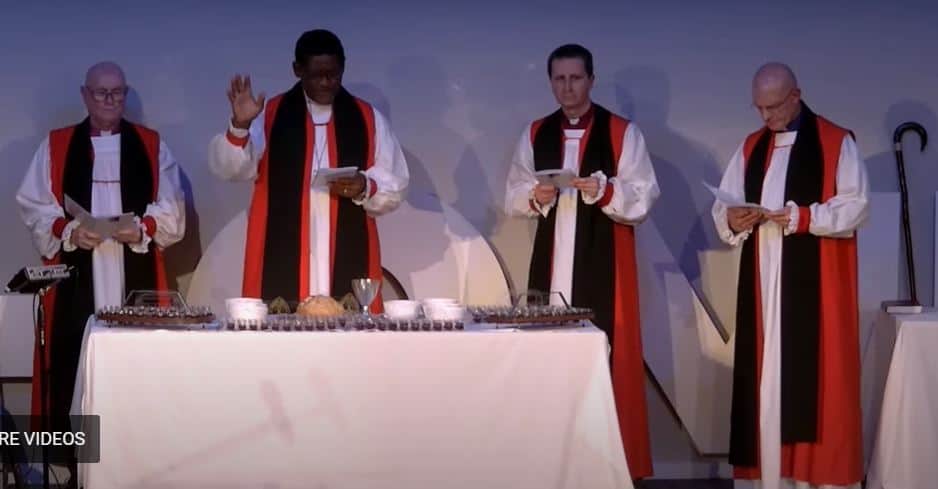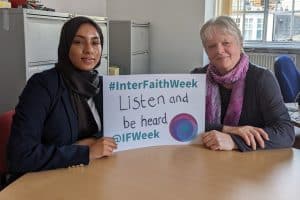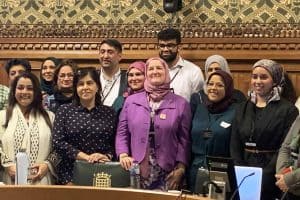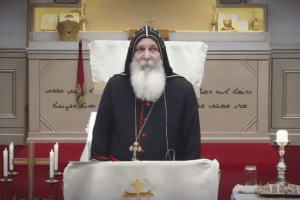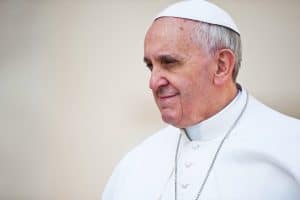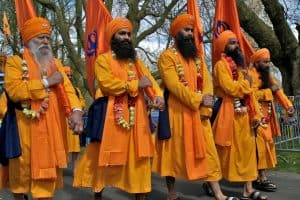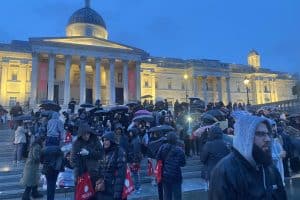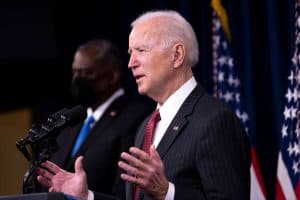An independent Anglican denomination has appointed four new bishops, as it continues to build and expand in expectation of more conservative churches defecting from the Church of England.
The Anglican Network in Europe (ANiE) consecrated three men (with a fourth due next year) to serve as suffragan — or assistant — bishops in a service in Hull last month, as part of ambitious plans to grow the movement from its 35 congregations today.
The consecrations are also part of a slow journey towards turning the breakaway network of churches into its own formal Anglican denomination, offering an alternative for conservative-minded members of the Church of England.
Some traditionalist clergy and parishes have warned that should the CofE propose changing its doctrine to permit same-sex marriage in a vote at the General Synod in February, they will be forced to abandon the church altogether.
What is ANiE?
The Anglican Network in Europe is a relatively new body, formed in 2020 as an umbrella group for two separate groups of churches: the Anglican Mission in England (AMiE) and the Anglican Convocation in Europe (ACE).
AMiE is the older of the two groups, and has been going for about 10 years. It is a network of about 25 conservative evangelical churches, each of them Anglican but not part of the Church of England.
While many of the churches began independently, they have joined forces to try to build a new Anglican Church in England. As well as taking in those quitting the CofE, AMiE also starts new churches and trains its own clergy from scratch.
ACE is a younger grouping, and includes about 10 congregations spread across Wales, Scotland, England, Portugal, and Germany. Although similarly conservative in outlook, ACE churches have a slightly more diverse background than AMiE, according to the Rev Dr Andrew Atherstone, a church historian at Wycliffe Hall, Oxford, and includes several charismatic-minded congregations.
ANiE is aiming to become, in time, a fully fledged denomination, with AMiE and ACE acting as de facto dioceses within it.
Why do they need bishops?
Although everyone involved has either left or was never part of the CofE, they remain committed to traditional Anglican teaching and structures. This includes the belief in a hierarchy of bishops overseeing churches, known in Anglicanism as episcopacy.
In 2017, another more established breakaway Anglican movement, the Anglican Church in North America (ACNA), made the Rt Revd Andy Lines a “missionary bishop” to Europe, with responsibility to oversee the AMiE churches. Lines was previously the director of an Anglican overseas mission agency.
Now, as AMiE has grown and united with ACE, the groups felt they needed more bishops in the leadership of their nascent denomination, hence the latest consecrations. Lines remains the senior bishop with oversight over both groupings, but there are now two suffragan bishops for both AMiE and ACE.
A core part of Anglican tradition is apostolic succession, the belief that bishops were originally set apart by Jesus when he called key members of his early followers to become apostles. These apostles then consecrated others as bishops over the years, who then consecrated some of their fellow believers as new bishops, creating a chain of succession which, it is believed, cascaded down the centuries to the present day.
Therefore, it is important that even though everyone involved in ANiE has repudiated the mainstream Anglican churches in the UK and Europe, their bishops cannot simply be self-appointed but must remain part of the historic apostolic succession.
This connection to the historic Anglican episcopacy is achieved via the Gafcon movement, which sent several senior archbishops to the Hull consecration service to lay hands on the new bishops as they were appointed.
What is Gafcon?
Gafcon was born out of the Global Anglican Future Conference in Jerusalem in 2008. Hundreds of delegates from Anglican churches across the world gathered shortly before the official Lambeth Conference of the same year to decry what they saw as backsliding and liberalism.
The conservative movement was born out of opposition to moves by the Episcopal Church, the official Anglican denomination in the United States, to shift its teaching on sexuality. This was encapsulated by the appointment of Gene Robinson, a priest living openly in a gay relationship, as a bishop in 2003.
Furious at this breach of traditional Anglican doctrine, the Gafcon churches — which were most heavily represented by churches from Africa and Asia — agreed to come together as an alternative centre of gravity within the global Anglican Communion, holding fast to conservative teaching that opposed gay marriages, relationships and blessings.
Although it began as a movement of official Anglican churches combating theological liberalism, over time Gafcon has evolved to include some conservatives who have broken away from the Anglican mainstream. Most notably, this includes ACNA, which brings together a diverse group of American and Canadian Anglicans who left the official churches in those countries in protest at their shift towards affirming LGBTQ+ relationships.
As it has already done in the US, Gafcon is now supporting and encouraging the creation of a breakaway church in the UK, which is what ANiE will eventually become. Several senior Gafcon figures, including the heads of the Anglican churches in Rwanda and Nigeria, travelled to the Hull service to consecrate the new bishops.
This is particularly notable. These archbishops refused to come to this summer’s Lambeth Conference in Kent, convened by the Archbishop of Canterbury, in protest at the presence of same-sex partnered bishops from America and Canada.
What’s next for Anglican Network in Europe?
The Rt Rev Lee McMunn, who leads an AMiE church in Scarborough, and was one of those appointed to be a bishop for the network, said the dream was to eventually evolve ANiE into becoming its own Anglican denomination, much like ACNA.
Because AMiE had originally developed as a loose, informal movement, it did not have much of the paraphernalia of a typical Anglican church such as canons (written laws detailing its theology and institutions) or synod meetings, McMunn explained.
“What we had there was a culture of mission, of church planting, of outreach, and a real bond of relationship. So that was great, but that sort of thing doesn’t last the time and isn’t properly Anglican. This is about building a structure that sends a signal about the future.”
He resisted efforts to tie the future of ANiE solely to the CofE’s tortured internal conflicts over sexuality, and said his network was instead focused on its own plans. Rather than solely waiting for more conservative defectors from the CofE, ANiE’s new bishops intended to train and ordain their own vicars who could then start new churches. To this end the group have identified 50 English towns which lack, in their words, a “Bible-teaching Anglican church”.
The four new bishops mean ANiE now boasts a bishop-to-congregation ratio of one to seven, significantly more than official Anglican churches (for contrast, the CofE has about 110 parishes for each of its bishops). But McMunn said this was both to create space for future growth, and to model a different kind of episcopacy, where clergy could have meaningful pastoral relationships with their bishop.
“We’ve got ordained pastors in the Church of England increasingly contacting us to say, ‘I don’t see my future in the Church of England.’ And we say to them come and join and one of the things that we will provide for you is episcopal care, where actually you’re not trying to defend your church family from the bishop but instead you’re inviting your bishop into your life to care for you and your church family. And we need that promise to be credible.”
To become a fully fledged Anglican church, ANiE probably needs at least one other diocese or network of churches to join, Atherstone said. He reported a grouping of Nigerian Anglicans in England have asked to join ANiE, but received a sharp rebuke by the Archbishop of Nigeria, ironically one of the Gafcon leaders who has backed the creation of ANiE.
Unlike the CofE and traditional Anglican churches, ANiE does not have geographically based dioceses, with the formal territory of ACE and AMiE overlapping. Another sign of innovation, and potential future discord, is that each of the two networks have slightly different theological principles. Most notably, AMiE has written it into its canons that only men can be vicars or bishops, while ACE has agreed to allow each individual church to decide if it wants women to be able to become the vicar.
McMunn insisted it had been a “wonderful joy” to join up with ACE despite these differences. Everyone involved was signed up to Gafcon’s Jerusalem Statement and the CofE’s historic Book of Common Prayer and the Thirty-Nine Articles, he added. “There’s no liberalism or no revisionism. But there are some issues were some take a different point of view.”
Will conservatives split from the CofE in 2023?
Some observers have said ANiE is building up its structures in preparation for new defectors from the CofE next year. In February, CofE bishops will finally bring forward their proposals about same-sex relationships and marriage. Although their decision is not yet clear after almost a decade of internal consultation, debate and wrangling, many expect some kind of shift in teaching towards a more progressive approach to LGBTQ+ people. Last week a handful of serving senior bishops broke cover to argue for gay marriage in church.
Some conservatives have said that if the CofE changes its doctrine of marriage to allow same-sex couples to marry, they will have to abandon the denomination altogether. McMunn said they were already seeing a rise in the numbers of CofE vicars inquiring about joining in frustration at the church’s trajectory, but did not expect a flood of new members. “In the past, I think some people have seen AMiE as the kind of lifeboat for those leaving the Church of England. The first thing you need to keep on saying is that we are for the people of Europe, this lost continent that needs to hear the good news about Jesus. But we also have an eye also on other fleets that we think are in trouble, and the Church of England is one of those fleets.”
But quitting the mainstream official Anglican body was not a small thing, he cautioned, noting it would mean leaving behind church buildings, clergy homes and long-term sustained funding to join the scrappy start-up that is AMiE.
Rather than hoping for explosive growth from a huge CofE schism, McMunn said he and his colleagues had plans for steady expansion via church planting. Their targets were to start 10 new congregations by 2025, and a further 20 by the end of the decade.
“The reality is, there’s so much to be done. There’s so much need in our country,” he said. For centuries the terms Church of England and Anglican were synonymous but that was no longer the case, he added. “Therefore, England is not the territory of the Church of England. It is the territory of Christ and we are trying to do our part as faithful Anglicans.”
Is ANiE the first breakaway Anglican church in Britain?
No. Atherstone said there have long been small outfits which follow Anglicanism without being aligned to the CofE. The longest-lasting is the Free Church of England, which split in the 1840s mostly over a row with one bishop in Devon. It gradually multiplied into a national network of congregations, and today boasts 15 parishes across England, and one each in France and Russia.
A second smaller breakaway is the Church of England (Continuing), which was established in the 1990s during the conflict over the ordination of women priests. It has only four congregations and two ministers and has remained very small.
“What’s unusual about the Anglican Mission in England is that it’s quite a large number of churches from a standing start,” Atherstone said. “And they are very much on the front foot in terms of church planting.” Previous networks have simply gathered Anglicans who have seceded from the CofE, whereas AMiE is also managing to attract younger ministers at the start of their careers who are choosing to join them, to start churches from scratch, he said. The deep connections with official Anglican churches overseas via the Gafcon movement also made ANiE different from previous breakaways, Atherstone added.
However, he argued it was unlikely the evangelical movement that remains within the Church of England would depart en masse should same-sex marriage be permitted in churches. There was a de facto united front between charismatic and conservative evangelicals, centred on a revived body called the Church of England Evangelical Council, which is lobbying hard to create a quasi-autonomous grouping within the CofE. This might involve breaking off relations with certain bishops or diocesan structures, but without formally quitting the denomination.
One other route is also being explored by Jesmond Parish Church, a prominent conservative evangelical CofE congregation in Newcastle, which has rejected the oversight of its diocesan bishop because of her supposed support for a more affirming stance on LGBTQ+ issues. Several years ago, the Jesmond had one of its assistant clergy consecrated as a bishop by a small breakaway Anglican denomination in South Africa. This new bishop has remained a priest within the CofE, while also working with the South African breakaways and, confusingly, AMiE, in planting new non-Canterbury-aligned churches across England.
What’s been happening elsewhere?
The Anglicans are not the only denomination in which conservatives opposed to any compromise on marriage doctrine are wrestling with how to proceed. Methodists are also deeply divided on same-sex marriage, and have decided to split their largest denomination as a result.
The United Methodist Church — which claims seven million adherents in the United States and a further 4.4 million around the world — has been riven by tensions between conservatives and progressives for years, culminating in a fiercely contested vote in 2019 over whether to amend their rules to permit gay couples to marry in church.
Despite the traditionalist side narrowly winning the vote at the 2019 meeting, the church decided a formal schism was the only way forward and have since set up the Global Methodist Church as a new home for conservative congregations unable to countenance gay marriage. After a series of delays caused by the pandemic, this division is expected to take place in 2024, after which the liberal rump left behind will likely move on to permit same-sex marriage.
However, the drawn-out process has frustrated some on both sides, meaning the conservative church has already launched with hundreds of parishes, and a separate pro-LGBTQ+ liberal Methodist denomination has also been set up for progressive congregations who refused to wait for the formal divorce to take place.

